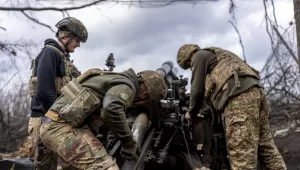Foreign Policy Empathy: Imagine Really Being There
To understand the Baltics or Poland today, shift perspective. Imagine standing on one side of the Charles River (or the Hudson, or the Potomac). Imagine on the other shore — not across the city, not across a state — but across the river is the Russian Federation (or a state believed to be a revisionist power). And imagine standing not on just American territory, but the very edge of the U.S. sphere of protection—the boundary before which U.S./NATO guarantees apply, and beyond which lies instability, coercion, a very different world.
For Estonia, this is not metaphor. With a population of less than 1.4 million, Estonia borders Russia directly; about one quarter of its population are native Russian-speakers, with many of them concentrated in Ida-Virumaa, the easternmost county, right up against the Russian border. For people there, when fighter jets enter Estonian airspace, when Russian aircraft fly without transponders or announce no flight plan, when rumors of sabotage or espionage flicker, it is visceral. People do not wake every morning hoping nothing happens; they wake feeling that an incident could spark something larger.
This sense of threat is not paranoia. It is grounded in history and geography: Estonia was occupied during WWII, then incorporated into the Soviet state; post-1991, it regained independence — but independence does not erase the memory of proximity, the presence of a powerful neighbor, or a minority whose loyalties may be under pressure. Latvia shares this exposure: it too has a direct land border with Russia, along with a sizeable Russian-speaking population that Moscow has at times portrayed as vulnerable.
Next to its land border with Belarus, Lithuania faces another reality: Kaliningrad, Russia’s exclave between Lithuania and Poland, is only about a 3-hour drive from Vilnius. That is roughly the same as the distance between Boston and New York, or New York and Washington, D.C. For Lithuanians, the proximity of a heavily militarized Russian territory is a constant, everyday fact — not something visible only on the map. This sense of exposure is precisely why NATO’s role matters so deeply in the region.
Article 5: Guarantee of a Mutual Defense Umbrella, Not a Magic Cloak
Everybody invoking Article 5 knows what it says: an attack on one NATO member is an attack on all. Yet, despite its clarity in principle, it remains — in practice — a theoretical guarantee. No live event since NATO’s founding has ever triggered a full Article 5 military response against Russia (though the invocation of allied consultation / readiness has happened). What will happen if Article 5 is ever triggered is not known with certainty.
The deterrent effect of NATO depends heavily on the U.S. security guarantee. European states have been discussing building up their own defense capabilities, more robust European Union (EU) defense initiatives, more autonomy in military production, etc. But for the Baltic states and Poland, and for many in Central and Eastern Europe, the perception remains that in a crisis, it is U.S. forces, U.S. political will, and U.S. resources that will make the difference between defense and abandonment. The EU may be about prosperity and regulation, but NATO is about survival.
Public opinion across the Baltic states further underlines NATO’s relevance. In Estonia, surveys show that around 80 percent of the population support NATO membership, with nearly two-thirds strongly in favor. Similar levels of support are found in Latvia and Lithuania. In all three countries, the majority of citizens support at least maintaining current levels of defense spending, according to national polls. These are not small margins; they reflect a commitment born of perceived existential risk. For the Baltics, NATO is not a diplomatic ornament but the core of security.
NATO’s Article 5 is more than doctrine, but it is not a guarantee one can test in advance. Its credibility depends on readiness, signaling, capacity, and above all a willingness among allies to act. In other words, Will the umbrella really open up when rain comes? And what exactly happens if it does?
What Is Russia Trying to Achieve?
So what is Russia trying to achieve with these provocations — the drones over Poland, the MiG-31s violating Estonian airspace, the sharp denials and dismissals at the UN Security Council? Moscow insists these are misunderstandings, accuses European leaders of hysteria, and frames the West as the true “party of war." But the pattern feels familiar. In the weeks before the invasion of Ukraine in 2022, Russian forces circled, tested, and created uncertainty. Their aim was not only to prepare the ground militarily but also to spread fear and to make escalation itself part of the psychological landscape.
Russia also knows this fear well. It understands the vulnerabilities of the Baltic states — their size, their geography, their internal debates — almost intimately. After all, only 35 years ago these countries were part of the Soviet Union. For Moscow, the anxieties of populations that live daily with the knowledge of their proximity are not abstract; they are familiar pressure points, and ones it can exploit.
Seen in this light, recent incidents in Poland and Estonia (and Romania, though not analyzed in the scope of this commentary) look more like deliberate ambiguity. Unarmed drones crossing borders, fighter jets with transponders switched off lingering in NATO airspace — not open acts of war, but enough to unnerve publics, force governments into emergency meetings, and raise questions about how the Alliance would respond if a line were crossed more clearly. Europeans are alert to the risks, but the increasingly charged rhetoric also exposes a vulnerability: in a climate of constant pressure, misinterpretations or hasty reactions could push events toward escalation. By denying, mocking, and casting doubt at every turn, Russia keeps the narrative confused and the atmosphere tense.
The danger is obvious: a single miscalculation, a crash, or a fatal mistake could turn these “tests” into escalation with consequences far beyond the border zone.
Conclusion
The recent incidents on NATO’s eastern flank are signals that deserve close attention. The Baltics and Poland are living with a proximity to risk that most of us can only imagine. Article 5 may remain untested, but the dangers of miscalculation are all too real. Escalation in this context would not be contained at the frontier; it would reverberate across the continent.
That is why the imperative now is not bellicose rhetoric or constant reaction, but careful observation, steady nerves, and genuine attentiveness to the signals coming from the borderlands. Staying alert must also mean staying calm: vigilance should not spill over into hasty decisions that could make matters worse. Foreign policy is, after all, closer to a game of chess than to a sprint — what looks like a threatening figure on the board is sometimes positioned to intimidate rather than to strike, but should also not be underestimated. The challenge for Europe is to read the moves with precision, anticipate rather than chase, and avoid stumbling into escalation.
Statements and views expressed in this commentary are solely those of the author and do not imply endorsement by Harvard University, the Harvard Kennedy School, or the Belfer Center for Science and International Affairs.




